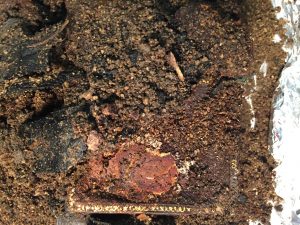In this post, Dennis Piechota, the archaeological conservator at the Fiske Center, recounts the discovery of the central objects in the Cole’s Hill cache. In the field, we recognized that we had something rectangular and fragile, with leather components, so we transferred it directly to Dennis’s care at the Fiske Center, rather than letting it wait at the field lab. You can read more background about the deposit here, and additional posts about other objects from the cache here.
–CMB
From Dustpan to Daguerreotype
By Dennis Piechota
When extremely fragile and unidentifiable artifacts are encountered in the field they are often block-lifted with the surrounding soil matrix and transported to the laboratory where excavation can continue along with conservation and identification through microscopic analysis.
In the field one uses whatever supports are at hand to lift out a fragile artifact, in this case some aluminum foil on a dustpan. When received in the lab we saw only the foil-lined unknown assemblage shown above containing something fibrous and rectangular hidden in a mass of soil. It was transferred onto an archival cardboard support that could be placed in the refrigerator when not in treatment.
Exploratory cleaning began with soft brushing which showed that the fibers came from a single braid of blonde human hair. And next to the braid was a common water-worn rock that lay atop a group of four gold-leafed leather-bound containers.
The braided hair, though originally unpigmented, was now stained brown by contact with the soil. It was consolidated with a cellulosic resin just enough to lift it free of the assemblage and place it on a study/storage support.
Under the braid we found the fragmentary remains of a red paper that appeared to be tied in place with black silk ribbon.
Further cleaning showed a two-by-two stack of four 19th-century photograph cases, the type of hinged display case used for ambrotypes and daguerreotypes. Composed of leather-covered wood frames, their interiors were originally lined with velvet with the photograph held in place by an etched metal mat called a ‘protector’. We had no idea at this point how much of the interiors, especially the sensitive photographic imaging, would be preserved.
One by one the cases were removed and their exteriors were stabilized enough to be opened to examine the four images inside.

A daguerreotype of a standing young man, wearing what appears to be a uniform with a bag slung from his left shoulder and a cap with cockade in his gloved left hand.

Another daguerreotype, this one relatively poorly preserved, shows a young woman in a gingham check dress with empire waist.
Though these images clearly show the effects of their burial in a soil environment for over a century, with 100 seasons of wet springs, hot summers and freezing winters, it is remarkable that any imaging has survived at all.
Currently the photographs have been sent to the specialists in photographic conservation at the Northeast Document Conservation Center. Analysis and interpretation of these amazing finds will continue upon their return.






